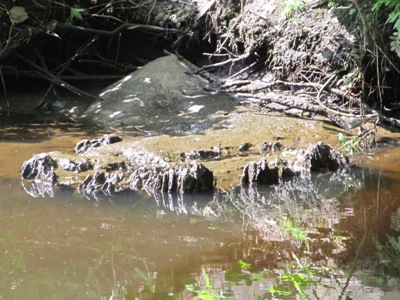Tree stumps are among the most common structures encountered when fishing in freshwater. These obstructions provide important cover for a number of freshwater fish species. Tree stumps occur in a variety of habitats, with each situation supporting a unique combination of fish and forage species.
In most areas, stumps occur as a result of man made flooding. Small mill ponds and other impoundments are often lined with stumps. Many of these ponds were built by damming small creeks or streams. Before flooding the pond, landowners often cut timber from the original stream banks. As water level rose, fields of stumps were covered by water and silt, which often preserved them for centuries.
Other impoundments such as water reservoirs and man-made lakes were created on a much larger scale. Many of these containments cover hundreds of acres and contain a wide range of structural habitats. These larger lakes often feature extensive stump beds. Some lakes contain entire tree trunks, still standing below the surface or partially exposed.
Another situation where stumps are found occurs along tidal rivers and swamps. Many of these areas once contained enormous cypress trees, oaks, pines, cedar and other valuable timber. Loggers cut many of the prime trees that grew along the river banks. Although centuries have passed, these massive structures remain, preserved by the tannic water found in these habitats.
When fishing stumps, it is important to understand which species are found locally as well as the forage foods that fish are targeting. In many areas, stumps will support an entire ecosystem of aquatic life. Tiny fish, aquatic insects, crayfish and other invertebrates often live among stumps. These attract panfish such as crappie, sunfish, rock bass, perch or other species.
In areas where current flows are substantial, stumps provide important refuge. The eddies that form around stumps attract forage species such as shad, herring, shiners and other baitfish. As the variety of fish and other forage species becomes more and more diverse, top predators become more common.
Some species, such as largemouth bass will take up residence, claiming and defending a single stump or group of stumps. Others, such as musky and northern pike may patrol a large area, moving from stump to stump in search of prey.
When fishing stumps for largemouth, smallmouth or other top level gamefish, anglers often carry an arsenal of rods, each equipped with a specialized lure. Some rigs may represent local baits, such as frogs, crawfish or forage fish. Other lures may not look at all like natural forage species, but are known to incite strikes from territorial fish.
For deeper stumps, anglers often select lures that are less likely to be lost among the maze of structure. These include Texas rigged worms, un-weighted senko type worms, weedless jig and pigs or other selections.
Another important option for fishing over stumps is the dropshot rig. This variation utilizes a small weight at the bottom with a lure rigged several inches above. Dropshot rigs can be an effective way to present soft plastics or other lures in areas where hangs are a problem. Anglers that specialize in fishing stumps or other bottom debris soon learn to tie the weight on with a weak knot. This allows the lure, hook and leader to be recovered if the weight gets caught on the structure.
In some situations, anglers do not fish right on top of submerged stumps. Instead they drift or manuver the boat across debris, casting mid depth lures. Crankbaits, jigs and other lures can be effective if the retrieval keeps them well above the hangup zone.
In the Mid Atlantic and many southern areas, stumps occur in tidal zones where they are constantly submerged and exposed. These shallow stumps often have hollow centers, surrounded by razor sharp outer shells. This structure presents a variety of challenges to anglers. During high tides, most or all of the structure is hidden, making fishing difficult. At low tides, these ancient stumps appear above the waterline, allowing anglers to target them more precisely.
In these habitats, anglers use slightly different techniques. Soft plastics are still important, but the shallow locations of these stumps allow anglers more opportunities to sight cast lures precisely. In addition to plastic worms, frogs, buzz baits, spinnerbaits, small crank baits and other suitable lures can be utilized.
In northern lakes and streams, stumps can be important structure. In moving water, smallmouth are quick to take up position in the eddies that form behind stumps. These primary diet of these fish is often crayfish and lures that resemble these crustaceans often produce well when fished near tree stumps.
Stumps are also important areas for catching panfish. Sunfish, crappie, rock bass, yellow perch, white perch and other panfish all favor stumps and downed timber. As with bass fishing, anglers must often resort to specialized tackle in order to fish these areas effectively.
Specialized snag-resistant jigs, small spinnerbaits, weedless tube lures, and live minnows are among the most effective options when targeting panfish around stumps and downed timber. When stumps and other wood occurs in deep water, deep jigging above the these structures can be an excellent technique for catching crappie, sunfish, perch and other panfish.
